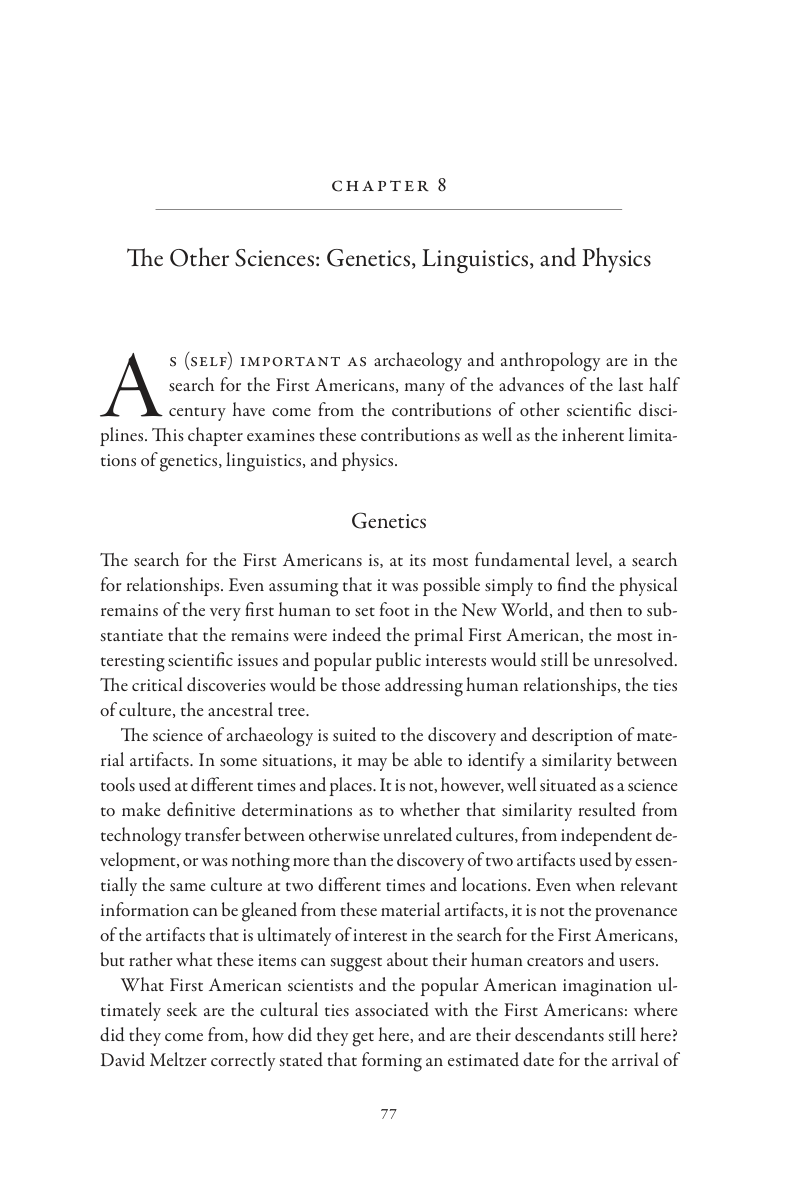Robert V. Davis reviews the genetic studies done on Native American origins.
- Type
- Book
- Source
- Robert V. Davis Non-LDS
- Hearsay
- Direct
- Reference
Robert V. Davis, The Search for the First Americans: Science, Power, Politics (Norman, OK: University of Oklahoma Press, 2021), 77–83
- Scribe/Publisher
- University of Oklahoma Press
- People
- Robert V. Davis
- Audience
- Reading Public
- Transcription
As (self) important as archaeology and anthropology are in the search for the First Americans, many of the advances of the last half century have come from the contributions of other scientific disciplines. This chapter examines these contributions as well as the inherent limitations of genetics, linguistics, and physics.
Genetics
The search for the First Americans is, at its most fundamental level, a search for relationships. Even assuming that it was possible simply to find the physical remains of the very first human to set foot in the New World, and then to substantiate that the remains were indeed the primal First American, the most interesting scientific issues and popular public interests would still be unresolved. The critical discoveries would be those addressing human relationships, the ties of culture, the ancestral tree.
. . .
According to James Chatters, the mtDNA of modern American Indians typically falls into five distinct haplogroups. Three of those haplogroups—A, C, and D—are also found today in Siberia. A fourth—haplogroup B—is typical in modern southeast Asians. Finally, haplogroup X—typically Eurasian—is also found in modern American Indians. It should be remembered that these associations are not between First Americans and ancient non-New World inhabitants, but rather between modern American Indians and modern Old World inhabitants. The difficulty comes in projecting these relationships back through time. According to Meltzer, the ultimate reward is “to firmly link the most ancient and most modern Native Americans, determine the number of migrations, from whence and where they came, or even the route(s) traveled.”
Because American Indian haplogroups are not distributed equally across the New World population, geneticists can draw some conclusions from the variations in the distribution. “The pattern is suggestive of a sequence of migrations, a first one with D and C, a second one dominated by B, and a third consisting only of type A individuals. When haplogroup X came cannot be surmised from the geographic patterns, although there is some indication it may have first arrived on the northwest coast of North America.” Based on genetic analysis, Theodore Schurr concluded that “the American progenitors le their homelands between 24,000 and 35,000 years ago.” This is some ten to twenty thousand years earlier than either the Clovis or Monte Verde cultures that have been documented by First American scientists. The roughly one dozen ancient human remains in North America from which mtDNA has been analyzed have produced only haplogroups B, C, and D. “Haplogroup A, the most common haplogroup among living native North Americans, has not yet been found in remains older than 6000 B.C.,” which supports contentions that modern American Indians are descendants from a later migration from Siberia and not the First Americans. The subtlety of this analysis, both genetically and politically, is further compounded by aDNA studied by Frederika Kaestle at an ancient archaeological site in Windover, Florida. Kaestle concluded that the remains are “not A, not B, not C, not D, and not X. We’ve been able to prove what they’re not, but we don’t know what they are.” Conclusive answers are elusive, but new genetic evidence continues to be discovered that generally supports some version of a Beringia migration hypothesis.
- Citations in Mormonr Qnas
The B. H. Roberts Foundation is not owned by, operated by, or affiliated with the Church of Jesus Christ of Latter-day Saints.

